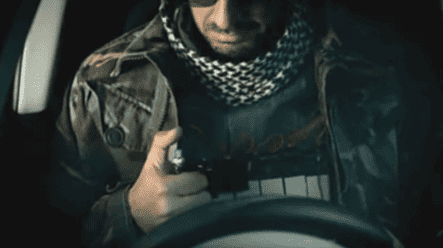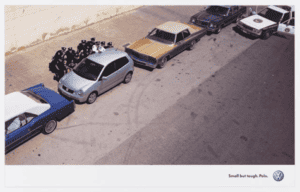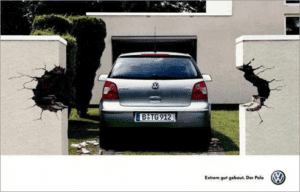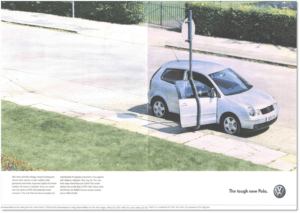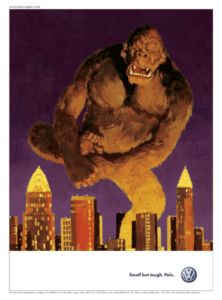Back in January 2005, The Guardian newspaper told the story of a hoax television commercial that became the most watched viral ad of that year – achieving over 2.3 million downloads (a pretty big deal at the time).
The fake ad caused huge controversy, depicting a suicide bomber who leaves his home, gets into his VW Polo and drives through London before parking outside a busy restaurant where diners are sat outdoors, oblivious to danger. We see the bomber press down on the detonator and we cut to a shot of the car outside the restaurant as the bomb explodes.
And then the punchline.
The blast is contained entirely within the car. The intended victims are safe, and the ad ends with the strapline we all know:
Polo. Small but tough.
Of course, it’s horrific. And make no mistake, this was a bogus ad. Good production values, granted, but totally fake.
It was not made by VW’s advertising agency at the time (DDB), and they made it abundantly clear that it was nothing to do with them, understandably wanting to distance themselves from work that was clearly in very bad taste.
Whilst the makers of the ad made their apology for any offence caused, the spoof really highlights how powerful an advertising idea can be when it’s done right.
I’m not talking about the execution itself (ill-advised); I’m talking about the power of the POSITIONING behind the strapline.
If you take a look at the real Small but tough campaign over the years, you can find countless interesting and engaging executions, derived from this simple idea. More often than not, the ideas are entirely visual needing nothing but three words to explain them.
The award-winning ad that launched the idea is a classic of its time.
The message is simple – the Polo is so tough that police officers would choose to hide behind it during a shootout / hostage situation. Unlike the hoax ad earlier, we never see the crime itself – just the cops hiding behind a Polo in preference to the big gas guzzlers also parked in the vicinity.
The brilliance of the idea is based in its market positioning.
The Polo is a small car. It’s the way that people see it. It’s categorized (in the minds of the customer) as a small car. There’s a compartment in our brains that is reserved for small cars, and the VW Polo is one of many brands in it.
And when we’re thinking of buying a second (or third) car for a growing family, that’s the compartment we open.
Then of course we try to sort the wheat from the chaff. Fiat Panda? Renault Clio? VW Polo? Hyundai… something or other.
That’s where brand positioning really kicks in.
If we’ve got a family, we might be buying this car to transport babies. Children on the school run. Teenagers learning to drive. Precious cargo. We worry that small cars might be vulnerable. We worry that our loved ones are in danger.
So VW positions itself as the tough small car.
And at the same time (the really clever bit), by ‘owning’ this territory, VW is subtly suggesting that other small cars aren’t tough. That you’d be making a mistake by choosing a different small car. That you’d be willfully putting the people you care about at risk.
Notice that they’re not saying ‘tough’ on its own.
They couldn’t do that because Volvo ‘owned’ safety. Compared to a Polo, a Volvo is a tank.
But Volvo didn’t (and don’t) make small cars – so VW could be the ‘toughest’ small car.
Over the years at Really Helpful Marketing, we’ve run dozens, if not hundreds, of brand and creative courses where we use the VW Polo example as a creative challenge.
We present different versions of a brief and ask delegates (usually working in teams) to develop creative ideas. Usually these are people who have never created an ad before.
The first brief (Brief Type 1) offers very little direction – simply listing as many product benefits as we can think of.
Inevitably, the ideas we get back are completely disparate. No two ideas even remotely related.
The second brief is completely prescriptive (Brief Type 2), going as far as to explain exactly what type of person to depict in what situation, and using a headline that says something about….
As you might expect – the ideas lack any creativity at all.
The last brief they’re asked to work on (Brief Type 3 – a bit of a rarity) gives the work real focus, without restricting creativity.
No, you’re not reading an excerpt from Goldilocks and the Three Bears. This is real.
We give them the line ‘Small but tough’ and let them play with that. The ideas that result from this brief are almost always excellent – and not a million miles away from the standard of thinking we’ve seen from VW over the years.
Really. Some of the ideas are inspired.
As an exercise it proves that when you’re working with a clear positioning and a single, simple idea – then it’s much easier to create advertising that gets cut through.
The Small but tough campaign hasn’t been around for a while. VW seemed to pull away from it – I’d be interested to know why. Maybe other brands gained a reputation for toughness, but I can’t see why that would be a problem when they clearly owned the ‘small but tough’ territory. Maybe toughness was no longer considered to be an issue – did consumers assume that toughness and safety was a given in any car?
Was ‘small but tough’ failing to differentiate?
Maybe a new marketing director wanted to put their own stamp on things. It happens.
Today, there’s no real clarity about the Polo’s market position. Take a look at the website – it talks about ‘the new Polo’. It seems to be majoring on design – and whilst it’s a nice-looking car, attractiveness is in the eye of the beholder. It’s subjective. Not a territory they can own.
The important bit about positioning is that you occupy a space in the customers’ mind.
A space that allows you to ram home the same message over and over again – and it doesn’t matter how ridiculous the execution is, the consumer will accept it, even expect it.
Even when a viral ‘ad’ appeared to be depicting the VW Polo as the hero in a terrorist attack, it didn’t feel completely off-beam.
In marketing, a really clear positioning, that offers countless creative ways to express it – is kind of priceless. And when you have an advertising idea that’s so famous you’re getting spoofed, you can be reasonably sure you’re on the right track.
There’s a fine line between bravery and stupidity. So let’s just say that the decision to move away from ‘small but tough’ was a very brave decision.

